Yu-Gi-Oh is a card game targeted toward children. However, unlike most TCG, the nitty-gritty mechanics are pretty complicated. This article will look at the many rulings of Yu-Gi-Oh that beginning players likely made when playing Yu-Gi-Oh TCG.
Ritual Summoning - Pebble Ruling
 SCENARIO: Opponent activates Black Illusion Ritual and tries to tribute 2 Dandylion monsters to Ritual Summon Relinquished. You then had to explain to your opponent how they can't tribute the second Dandylion because the first Dandylion already meets the level requirement. Your opponent then responded, "But the Ritual Spell says I CAN tribute monsters with higher levels than Level 1".
SCENARIO: Opponent activates Black Illusion Ritual and tries to tribute 2 Dandylion monsters to Ritual Summon Relinquished. You then had to explain to your opponent how they can't tribute the second Dandylion because the first Dandylion already meets the level requirement. Your opponent then responded, "But the Ritual Spell says I CAN tribute monsters with higher levels than Level 1".
Ritual Summoning is an OG Special Summoning mechanic. If you Ritual Summon a Ritual Monster, the player must tribute monsters whose levels are equal or higher (depending on the Ritual Spell) than the level of the Ritual Monster you're summoning. For example, if I want to Ritual Summon the Level 6, Cyber Angel Benten, I must tribute a Level 6 or higher monster to fulfil the level requirement. However, if I don't have a monster equal to the Ritual Monster's level, I can combine the levels of several monsters to meet the requirement, e.g. tributing a Level 2 monster and a Level 4 monster (total level 6).
Now here is the pebble ruling. Basically, the pebble ruling means using ONLY what the Ritual Summon requires. For example, If I want to Ritual Summon a Level 6 monster, you cannot tribute both a Level 7 and a Level 3 monster because the Level 7 monster already meets the level requirement. Therefore, you can only tribute the Level 7 monster. This ruling makes sense to prevent players from using more than they need to, but it causes serious problems for several Ritual Archetypes (e.g. Vendread, Megalith and Drytron + Relinquished).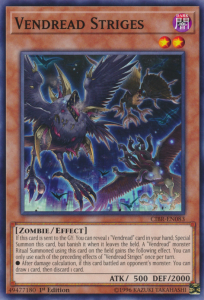
For Megalith, before the release of Megalith Phul, this ruling almost rendered Megalith clunky and unplayable since all their monsters were Level 4 and 8. All the Level 4 Ritual Monsters MUST use themselves as a ritual material to Ritual Summon. This causes a problem because if I want to Ritual Summon a Level 8 Megalith monster, I cannot use any of the Level 8 monsters as a tribute because Level 8 already meets the Ritual requirement. Therefore, I have to make sure I have a level 7 or lower monster in the hand or field to fulfil the ritual requirement.
For Vendread, this pebble ruling hurts their already terrible gameplay. Vendread is an archetype that wants the player to sacrifice as many materials as possible to power up your Ritual Monster. However, thanks to the pebbling ruling, this isn't possible. The highest Vendread Ritual Monster is a Level 8 monster. The main deck monsters include Houndhorde (Level 3), Revenants (Level 4), Striges (2 monsters) and Core and Anima (Level 1). If I use Revenants, Houndhorde and Striges as ritual material (total level is 9) to Ritual Summon the Level 8 Ritual, I can't use Anima and Core because I already meet the Level 8 requirement. There will 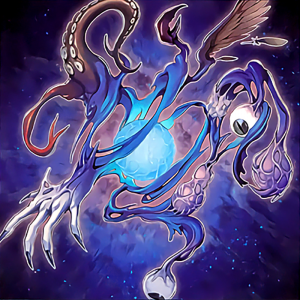 never be a scenario where a player can Ritual Summon a full-power Vendread monster because the pebble ruling prevents this from happening.
never be a scenario where a player can Ritual Summon a full-power Vendread monster because the pebble ruling prevents this from happening.
For Drytron and Relinquished, this ruling is harmful once again. Drytron Meteornis is a Ritual Spell that Ritual Summons a Ritual Monster by tributing a monster whose ATK meets the ATK value of the Ritual Monster you're trying to summon. Relinquished is a 0 ATK monster. This means the player doesn't need to tribute anything to Ritual Summon Relinquished. However, to perform a Ritual Summon, you MUST tribute at least one monster, but since tributing a monster for Relinquished would be considered more Tributes than necessary (Pebble Ruling), you cannot Ritual Summon Relinquished with Drytron Meteornis.
Chain Sequence
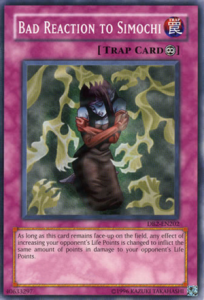 SCENARIO: Your opponent says "GG". He then activates 'Bad Reaction to Simochi' and proceeds to chain 3 'Gift Card' to 'Bad Reaction of Simochi'. You then say "Thank you" and increase your LP by 9000. Your opponent got angry and told you to read "Bad Reaction to Simochi". You then responded that he chained the cards incorrectly. Your opponent flipped the table and called you a nerd.
SCENARIO: Your opponent says "GG". He then activates 'Bad Reaction to Simochi' and proceeds to chain 3 'Gift Card' to 'Bad Reaction of Simochi'. You then say "Thank you" and increase your LP by 9000. Your opponent got angry and told you to read "Bad Reaction to Simochi". You then responded that he chained the cards incorrectly. Your opponent flipped the table and called you a nerd.
Chain is a mechanic that determines the order of effects resolution. Basically, when you activate a card effect, it creates a chain link. Every card that activates afterwards before the card resolves adds to that chain link. For example:
- Player A activates Pot of Greed (Chain Link 1)
- Player B chained Magic Jammer (Chain Link 2)
Once both players are happy for the effects to resolve, the effect resolves backwards, starting from the last chain link (in this case, it's Chain Link 2).
- Chain Link 2: Magic Jammer negates Pot of Greed
- Chain Link 1: Pot of Greed doesn't resolve (negated by Magic Jammer)
 Understanding how a chain works is essential in competitive play, as chaining certain cards can net you advantages if done correctly. Look at these two scenarios...
Understanding how a chain works is essential in competitive play, as chaining certain cards can net you advantages if done correctly. Look at these two scenarios...
Scenario 1:
- Player A activates Mystical Space Typhoon (Chain Link 1)
- Player B chain with Imperial Order (Chain Link 2)
- Player B then chains again with Scapegoat (Chain Link 3)
The effects then resolve backwards.
- Chain Link 3: Scapegoat summons 4 tokens
- Chain Link 2: Imperial Order negates Mystical Space Typhoon
- Chain Link 1: Mystical Space Typhoon is negated
Notice how Player B could negate Player A's spell and still summon their 4 tokens with Scapegoat by chaining certain cards in order? Now let's look at another scenario with the same cards but different chain link order.
Scenario 2:
- Player A activates Mystical Space Typhoon (Chain Link 1)
- Player B chain with Scapegoat (Chain Link 2)
- Player B then chains again with Imperial Order (Chain Link 3)
The effects then resolve backwards
- Chain Link 3: Imperial Order negates all spell cards
- Chain Link 2: Scapegoat is negated
- Chain Link 1: Mystical Space Typhoon is also negated
In this scenario, Player B's Scapegoat is negated because he chained Imperial Order after Scapegoat?
Similar to the above scenario, chaining can also gain a further player advantage by chain blocking the opponent. This means setting up a chain, causing your opponent to be unable to respond because the condition is no longer applicable. For example, let's have a look at these two scenarios.
Scenario 1:
P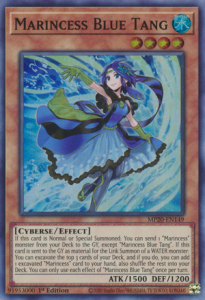 layer B has Ash Blossom in his hand. Player A sends Marincess Blue Tang to the grave to Link Summon Blue Slug.
layer B has Ash Blossom in his hand. Player A sends Marincess Blue Tang to the grave to Link Summon Blue Slug.
- Player A activates both Blue Tang and Blue Slug's effects.
- Player A then set Blue Slug's effect as Chain Link 1 (Chain Link 1).
- Player A set Blue Tang's search effect as Chain Link 2 (Chain Link 2).
- Player B chains Ash Blossom to Blue Tang's effect (Chain Link 3).
Chain resolves backwards:
- Chain Link 3: Ash Blossom negates Blue Tang's effect.
- Chain Link 2: Blue Tang's effect is negated.
- Chain Link 1: Blue Slug adds Blue Tang from the grave back to hand.
Scenario 2:
Player B has Ash Blossom in his hand. Player A sends Marincess Blue Tang to the grave to Link Summon Blue Slug.
- Player A activates both Blue Tang and Blue Slug's effects.
- Player A set Blue Tang's search effect as Chain Link 1 (Chain Link 1).
- Player A then set Blue Slug's effect as Chain Link 2 (Chain Link 2).
- Player B cannot chain Ash Blossom.
Chain resolves backwards
- Chain Link 2: Blue Tang searches out Marincess Wave.
- Chain Link 1: Blue Slug adds Blue Tang from the grave back to hand.
Notice how in scenario 2, Player B wasn't able to respond with Ash Blossom? That's because Player A has blocked Player B by ordering his chain-link differently, causing Blue's Tang's adding effect not to be the last thing to happen.
Missing the Timing (If & When)
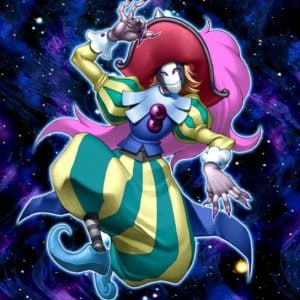 SCENARIO: Your opponent equipped Wonder Wand to Peten the Dark Clown. They then activate Wonder Wand's second effect, sending both it and Peten to the grave to draw two cards. They then try to activate Peten's effect to Special Summon, another copy of itself. You told your opponent no, as it misses the timing. Your opponent then berates you and says how Peten's effect activates when it's sent to the graveyard.
SCENARIO: Your opponent equipped Wonder Wand to Peten the Dark Clown. They then activate Wonder Wand's second effect, sending both it and Peten to the grave to draw two cards. They then try to activate Peten's effect to Special Summon, another copy of itself. You told your opponent no, as it misses the timing. Your opponent then berates you and says how Peten's effect activates when it's sent to the graveyard.
Missing the timing must be the most confusing ruling for many beginning players. In early Yu-Gi-Oh, many monsters have missing timing effects. This has been less common over the years, but Konami occasionally uses this ruling to balance certain archetypes (e.g. Yang Zing). To simplify it, missing the timing means certain effects can only be activated if it's the last thing to occur; otherwise, it misses the timing. For example, If I send Fortune Lady Light to the grave with Magical Dimension and then destroy a monster with Magical Dimension secondary effect, I cannot activate Fortune Lady Light's trigger effect because Light getting sent to the grave wasn't the last thing to happen (hence missing the timing). However, If I send Fortune Lady Light to the grave with Magical Dimension and choose NOT to destroy anything, I can activate Fortune Lady Light's Trigger effect because Light's getting sent to the grave was the last thing to happen. 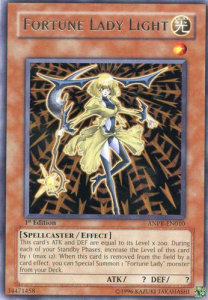
Now how do we know whether a card misses timing or not? Basically, you have to look for specific keywords in the monster's trigger effect condition. The keywords are 'if' and 'when'. Monsters with trigger effect conditions that start with 'if' never miss timing. Monsters with trigger effect conditions that start with 'when' will miss timing if it's not the last thing to occur (not always).
For example,
- When this card is sent to the Graveyard by a card effect: You can target 1 "Battlin' Boxer" monster in your Graveyard, except "Battlin' Boxer Glassjaw"; add that target to your hand. (Will miss timing if the condition is not the last thing to happen)
- If this card is sent to the Graveyard: Special Summon 2 "Fluff Tokens" (Plant-Type/WIND/Level 1/ATK 0/DEF 0) in Defense Position. (Never misses timing)
Now to make things complicated are effects that occur at the same time. Basically, if you can line up card effects so it happens simultaneously, then the monsters' effects won't miss timing regardless. Now how do we know if a card effect occurs simultaneously? They have the keywords, "and", "and if you do", "also", "then", "also, after that". Let's have a look at Fortune Lady Light again.
- Light's effects: "When this face-up card leaves the field by card effect: You can Special Summon 1 "Fortune Lady" monster from your Deck."
Let's have a look at Light's interactions with two other spell cards (Magical Dimension and Spellbook of Knowledge.
- Magical Dimension: "Target 1 monster you control; Tribute that target, then Special Summon 1 Spellcaster monster from your hand, then you can destroy 1 monster on the field.
- Spellbook of Knowledge: "Send to the GY either 1 Spellcaster monster you control..., and if you do, draw 2 cards."
If I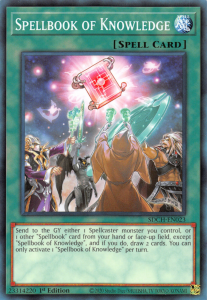 send Fortune Lady Light to the grave using Magical Dimension and then destroy a monster, I can't trigger Light's effect because destroying the monster was the last thing to happen and not Light's getting sent to the grave. However, if I send Light to the grave using Spellbook of Knowledge and then draw two cards, I can still trigger Light's effect because drawing two cards and sending Light to the grave happened simultaneously.
send Fortune Lady Light to the grave using Magical Dimension and then destroy a monster, I can't trigger Light's effect because destroying the monster was the last thing to happen and not Light's getting sent to the grave. However, if I send Light to the grave using Spellbook of Knowledge and then draw two cards, I can still trigger Light's effect because drawing two cards and sending Light to the grave happened simultaneously.
Now to make things even more confusing is mandatory effects. Basically, a card will never miss timing if the effect is compulsory, even if it uses the keyword 'when'. How do you know if a card effect is mandatory or not? You look for the keyword, "can". If a card effect has the keyword, 'can', the effect is optional and may miss its timing. For example, let's have a look at these four cards...
- Heraldic Beast Leo: "When this card is sent to the Graveyard: Add 1 "Heraldic Beast" monster from your Deck to your hand." (Never misses timing as it's a compulsory effect)
- Battlin' Boxer Glassjaw: "When this card is sent to the Graveyard by a card effect: You can target 1 "Battlin' Boxer" monster... add that target to your hand." (Will miss timing if it's not the condition isn't the last thing to happen)
- Fluffal Penguin: "If this card is sent to the Graveyard as a Fusion Material...: You can draw 2 cards, then discard 1 card. (Never misses timing despite being an optional effect due to the keyword "if")
- Sunny Pixie: If this card is sent to the Graveyard...: Gain 1000 Life Points." (Never misses timing)
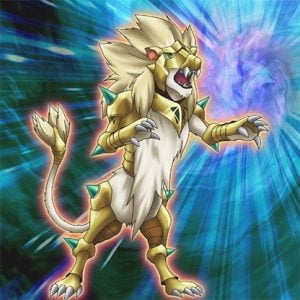
Destroy Vs Negate
SCENARIO: 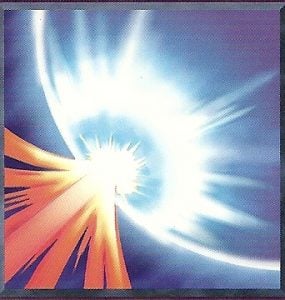 The opponent declares an attack. You responded by activating Mirror Force to destroy their attacking monsters. The opponent then chained Mystical Space Typhoon to destroy Mirror Force. You're then left sitting there explaining to the opponent how Mystical Space Typhoon doesn't negate and that they essentially wasted their Mystical Space Typhoon.
The opponent declares an attack. You responded by activating Mirror Force to destroy their attacking monsters. The opponent then chained Mystical Space Typhoon to destroy Mirror Force. You're then left sitting there explaining to the opponent how Mystical Space Typhoon doesn't negate and that they essentially wasted their Mystical Space Typhoon.
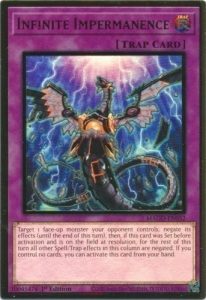 Basically, destroying and negating isn't the same thing. If I destroy something with a card effect, I'm not negating the effect. The effect may still go off if it was activated. Negating isn't the same as destroying either. I can negate something, but the card isn't destroyed (e.g. Infinite Impermanence). Unfortunately, many new players sometimes think having a card destroyed automatically means negating the card. It also doesn't help that most cards usually have both those wordings (e.g. Solemn trap cards), confusing players into thinking that if a card is destroyed, their effects are also negated.
Basically, destroying and negating isn't the same thing. If I destroy something with a card effect, I'm not negating the effect. The effect may still go off if it was activated. Negating isn't the same as destroying either. I can negate something, but the card isn't destroyed (e.g. Infinite Impermanence). Unfortunately, many new players sometimes think having a card destroyed automatically means negating the card. It also doesn't help that most cards usually have both those wordings (e.g. Solemn trap cards), confusing players into thinking that if a card is destroyed, their effects are also negated.
Now to make things more confusing, we have to look at how the "destroy" mechanic interacts with Continuous Spell and Trap cards and Field Spells. Continuous Traps and Spells and Field Spells need to be face-up to resolve their effects. If not, their effects cannot resolve, causing a situation similar to negation. For example, if an opponent activates the field spell, Trickstar Light Stage, to search for a Trickstar Monster, I can chain Mystical Space Typhoon to destroy Light Stage. Since Light Stage is no longer on the Field, its effect cannot be resolved. Therefore, the player cannot search for any Trickstar monster.
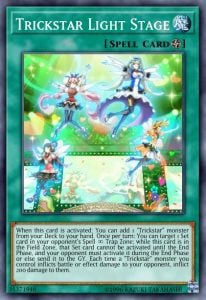
Spell Speed
SCENARIO: Your 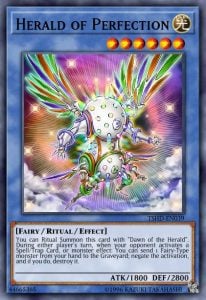 opponent has Herald of Perfection on the field. You activate Raigeki to nuke their field. Your opponent chained Herald to negate Raigeki. You then responded with Solemn Strike to negate Herald's effect. Your opponent then tries to respond with Herald's effect to negate Solemn Strike. You then told your opponent that they can't because Herald's effect is only Spell Speed 2 while Solemn Strike is Spell Speed 3. Your opponent then berates you and say, "Learn the game! This isn't the 5D anime. Speed Spell isn't a thing!"
opponent has Herald of Perfection on the field. You activate Raigeki to nuke their field. Your opponent chained Herald to negate Raigeki. You then responded with Solemn Strike to negate Herald's effect. Your opponent then tries to respond with Herald's effect to negate Solemn Strike. You then told your opponent that they can't because Herald's effect is only Spell Speed 2 while Solemn Strike is Spell Speed 3. Your opponent then berates you and say, "Learn the game! This isn't the 5D anime. Speed Spell isn't a thing!"
Spell Speed is a mechanic that tells the player what cards can be chained to what, or how "fast" they are. Every card effect has an associated Spell Speed. There are only 3 Spell Speed in the game, Spell Speed 1, Spell Speed 2 and Spell Speed 3.
- Spell Speed 1: Normal Spells, Field Spells (trigger and ignition effects), Continuous Spells (trigger and ignition effects), Equip Spells, Ritual Spells, Monster Flip Effects, Monster Ignition Effects, Monster Trigger Effects
- Spell Speed 2: Quick-Play Spells, Normal Trap Cards, Continuous Trap Cards, Quick Effects (Monsters, Trap and Spell cards)
- Spell Speed 3: Counter Traps
It's important to know this mechanic so you can interact wit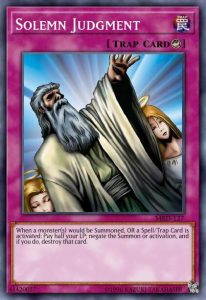 h your opponent's cards effect and chain cards accordingly. If the conditions are met, Spell Speed 1 cards can be chained to each other, but not to cards with Spell Speed 2 or 3. Spell Speed 2 can be chained to cards with Spell Speed 1 and 2, but not 3. Spell Speed 3 can be chained to Spell Speed 1, 2 and 3. For example, let's look at the following cards.
h your opponent's cards effect and chain cards accordingly. If the conditions are met, Spell Speed 1 cards can be chained to each other, but not to cards with Spell Speed 2 or 3. Spell Speed 2 can be chained to cards with Spell Speed 1 and 2, but not 3. Spell Speed 3 can be chained to Spell Speed 1, 2 and 3. For example, let's look at the following cards.
- Solar Flare Dragon: "During each of your End Phases: Inflict 500 damage to your opponent." (Trigger effect: Spell Speed 1)
- Nature's Reflection: "...any effect activated by your opponent that would inflict damage becomes an effect that inflicts damage to their Life Points." (Normal Trap: Spell Speed 2)
- Trap Stun: "Negate all other Trap effects on the field this turn." (Normal Trap: Spell Speed 2)
- Trap Jammer: "When your opponent activates a Trap Card during the Battle Phase: Negate the activation, and if you do, destroy it." (Counter Trap: Spell Speed 3)
- Solemn Judgment: "...a Spell/Trap Card is activated: Pay half your LP; negate the Summon or activation..." (Counter Trap: Spell Speed 3)
If Player A activates Solar Flare Dragon's effect to inflict 500 damage, Player B can chain with Nature's Reflection as Nature's Reflection is Spell Speed 2. Player A can then respond with Trap Stun to negate Nature's Reflection as Trap Stun is also Spell Speed 2. Player B can then chain with Trap Jammer to negate Trap Stun because Trap Jammer is a counter trap (Spell Speed 3). However, Player A can then chain Solemn Judgment to Trap Jammer because Solemn Judgment is also a counter trap, which is also a Spell Speed 3.




